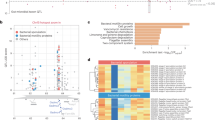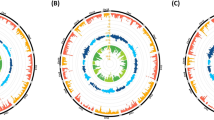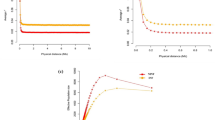Abstract
Resistance to the establishment of intestinal Entamoeba histolytica infection is dependent on the inbred mouse strain. In this work we used the inbred strains B6 (resistant), CBA (susceptible), B6CBAF1 and a backcross of B6CBAF1 to CBA to further examine the genetic basis of resistance. Mouse genotype was assessed with single nucleotide polymorphism and microsatellite markers and infection assessed by culture 9 days after intracecal E. histolytica challenge. The backcross population showed a male predisposition to culture positivity (P<0.002). F1 genotype at two loci on chromosomes 1 and 2 exhibited suggestive linkage with resistance to infection (P=0.0007 and 0.0200). Additional suggestive quantitative trait locus were observed on chromosomes 1, 9 and 13 for cecal parasite antigen load and histologic evidence of inflammation. Infection in C3H × B6 recombinant inbred mice supported the mapping data. Candidate B6 genes on chromosomes 1 and 2 were examined by microarray analysis of epithelial tissues from B6 vs CBA mice. This work shows a male predisposition to intestinal amebiasis and suggests that relatively few B6 loci can confer resistance in inbred mice. Future identification of regional candidate genes has implications for understanding the human variability to amebic infection.
This is a preview of subscription content, access via your institution
Access options
Subscribe to this journal
Receive 6 digital issues and online access to articles
$119.00 per year
only $19.83 per issue
Buy this article
- Purchase on Springer Link
- Instant access to full article PDF
Prices may be subject to local taxes which are calculated during checkout




Similar content being viewed by others
References
Walsh JA . Problems in recognition and diagnosis of amebiasis: estimation of the global magnitude of morbidity and mortality. Rev Infect Dis 1986; 8: 228–238.
Haque R, Duggal P, Ali IM, Hossain MB, Mondal D, Sack RB et al. Innate and acquired resistance to amebiasis in Bangladeshi children. J Infect Dis 2002; 186: 547–552.
Haque R, Mondal D, Duggal P, Kabir M, Roy S, Farr BM et al. Entamoeba histolytica infection in children and protection from subsequent amebiasis. Infect Immun 2006; 74: 904–909.
Irusen EM, Jackson TF, Simjee AE . Asymptomatic intestinal colonization by pathogenic Entamoeba histolytica in amebic liver abscess: prevalence, response to therapy, and pathogenic potential. Clin Infect Dis 1992; 14: 889–893.
Blessmann J, Ali IK, Nu PA, Dinh BT, Viet TQ, Van AL et al. Longitudinal study of intestinal Entamoeba histolytica infections in asymptomatic adult carriers. J Clin Microbiol 2003; 41: 4745–4750.
Gathiram V, Jackson TF . A longitudinal study of asymptomatic carriers of pathogenic zymodemes of Entamoeba histolytica. S Afr Med J 1987; 72: 669–672.
Acuna-Soto R, Maguire JH, Wirth DF . Gender distribution in asymptomatic and invasive amebiasis. Am J Gastroenterol 2000; 95: 1277–1283.
Houpt E, Barroso L, Lockhart L, Wright R, Cramer C, Lyerly D et al. Prevention of intestinal amebiasis by vaccination with the Entamoeba histolytica Gal/GalNac lectin. Vaccine 2004; 22: 611–617.
Haque R, Mondal D, Shu J, Roy S, Kabir M, Davis AN et al. Correlation of interferon-gamma production by peripheral blood mononuclear cells with childhood malnutrition and susceptibility to amebiasis. Am J Trop Med Hyg 2007; 76: 340–344.
Houpt ER, Glembocki DJ, Obrig TG, Moskaluk CA, Lockhart LA, Wright RL et al. The mouse model of amebic colitis reveals mouse strain susceptibility to infection and exacerbation of disease by CD4+ T cells. J Immunol 2002; 169: 4496–4503.
Asgharpour A, Gilchrist C, Baba D, Hamano S, Houpt E . Resistance to intestinal Entamoeba histolytica infection is conferred by innate immunity and Gr-1+ cells. Infect Immun 2005; 73: 4522–4529.
Hamano S, Asgharpour A, Stroup SE, Wynn TA, Leiter EH, Houpt E . Resistance of C57BL/6 mice to amoebiasis is mediated by nonhemopoietic cells but requires hemopoietic IL-10 production. J Immunol 2006; 177: 1208–1213.
Belley A, Keller K, Grove J, Chadee K . Interaction of LS174T human colon cancer cell mucins with Entamoeba histolytica: an in vitro model for colonic disease. Gastroenterology 1996; 111: 1484–1492.
Petri Jr WA, Smith RD, Schlesinger PH, Murphy CF, Ravdin JI . Isolation of the galactose-binding lectin that mediates the in vitro adherence of Entamoeba histolytica. J Clin Invest 1987; 80: 1238–1244.
Velcich A, Yang W, Heyer J, Fragale A, Nicholas C, Viani S et al. Colorectal cancer in mice genetically deficient in the mucin Muc2. Science 2002; 295: 1726–1729.
Gottke MU, Keller K, Belley A, Garcia RM, Hollingsworth MA, Mack DR et al. Functional heterogeneity of colonic adenocarcinoma mucins for inhibition of Entamoeba histolytica adherence to target cells. J Eukaryot Microbiol 1998; 45: 17S–23S.
Whitmore AC, Whitmore SP . Subline divergence within L.C. Strong's C3H and CBA inbred mouse strains. A review. Immunogenetics 1985; 21: 407–428.
Miron M, Woody OZ, Marcil A, Murie C, Sladek R, Nadon R . A methodology for global validation of microarray experiments. BMC Bioinformatics 2006; 7: 333.
Lotter H, Jacobs T, Gaworski I, Tannich E . Sexual dimorphism in the control of amebic liver abscess in a mouse model of disease. Infect Immun 2006; 74: 118–124.
Strachan NJ, Watson RO, Novik V, Hofreuter D, Ogden ID, Galan JE . Sexual dimorphism in campylobacteriosis. Epidemiol Infect (in press).
Ge Z, Feng Y, Taylor NS, Ohtani M, Polz MF, Schauer DB et al. Colonization dynamics of altered Schaedler flora is influenced by gender, aging, and Helicobacter hepaticus infection in the intestines of Swiss Webster mice. Appl Environ Microbiol 2006; 72: 5100–5103.
Fox JG, Wang TC, Rogers AB, Poutahidis T, Ge Z, Taylor N et al. Host and microbial constituents influence Helicobacter pylori-induced cancer in a murine model of hypergastrinemia. Gastroenterology 2003; 124: 1879–1890.
Aebischer T, Laforsch S, Hurwitz R, Brombacher F, Meyer TF . Immunity against Helicobacter pylori: significance of interleukin-4 receptor alpha chain status and gender of infected mice. Infect Immun 2001; 69: 556–558.
Kiyota M, Korenaga M, Nawa Y, Kotani M . Effect of androgen on the expression of the sex difference in susceptibility to infection with Strongyloides ratti in C57BL/6 mice. Aust J Exp Biol Med Sci 1984; 62 (Part 5): 607–618.
Nagai Y, Akashi S, Nagafuku M, Ogata M, Iwakura Y, Akira S et al. Essential role of MD-2 in LPS responsiveness and TLR4 distribution. Nat Immunol 2002; 3: 667–672.
Wieland CW, Florquin S, Maris NA, Hoebe K, Beutler B, Takeda K et al. The MyD88-dependent, but not the MyD88-independent, pathway of TLR4 signaling is important in clearing nontypeable haemophilus influenzae from the mouse lung. J Immunol 2005; 175: 6042–6049.
Clarke AR, Jones N, Pryde F, Adachi Y, Sansom OJ . 53BP1 deficiency in intestinal enterocytes does not alter the immediate response to ionizing radiation, but leads to increased nuclear area consistent with polyploidy. Oncogene 2007; 26: 6349–6355.
Yan L, Stanley Jr SL . Blockade of caspases inhibits amebic liver abscess formation in a mouse model of disease. Infect Immun 2001; 69: 7911–7914.
Cliffe LJ, Potten CS, Booth CE, Grencis RK . An increase in epithelial cell apoptosis is associated with chronic intestinal nematode infection. Infect Immun 2007; 75: 1556–1564.
Carlstedt I, Lindgren H, Sheehan JK, Ulmsten U, Wingerup L . Isolation and characterization of human cervical-mucus glycoproteins. Biochem J 1983; 211: 13–22.
Haley CS, Knott SA . A simple regression method for mapping quantitative trait loci in line crosses using flanking markers. Heredity 1992; 69: 315–324.
Lander E, Kruglyak L . Genetic dissection of complex traits: guidelines for interpreting and reporting linkage results. Nat Genet 1995; 11: 241–247.
Acknowledgements
This work was supported by research grants from NIH (AI071373, AI052444), the Crohn's and Colitis Foundation of America, the Commonwealth of Virginia Technology Research Fund. SH was supported by a grant-in-Aid for Scientific Research from the Ministry of Education, Science, Technology, Sports and Culture of Japan and by the Mochida Memorial Foundation for Medical and Pharmaceutical Research. We thank Anna Velcich for provision of the Muc2 KO mice, Craig Coopersmith for the FVB mice, William A Petri Jr, for helpful advice and David Lyerly, Techlab, for the E. histolytica II ELISA kits. We acknowledge the UVA Research Histology Core of the Center for Research in Reproduction and thank Sharon Hoang of the UVA Digestive Health Center of Excellence Histology Core for immunohistochemistry support, whose work was partially supported by the Morphology/Imaging Core of the National Institutes of Health-funded Silvio O Conte Digestive Diseases Research Center (P30DK56703).
Author information
Authors and Affiliations
Corresponding author
Additional information
Disclosures
The authors have no conflicting financial interests.
Supplementary Information accompanies the paper on Genes and Immunity website (http://www.nature.com/gene)
Supplementary information
Rights and permissions
About this article
Cite this article
Hamano, S., Becker, S., Asgharpour, A. et al. Gender and genetic control of resistance to intestinal amebiasis in inbred mice. Genes Immun 9, 452–461 (2008). https://doi.org/10.1038/gene.2008.37
Received:
Revised:
Accepted:
Published:
Issue Date:
DOI: https://doi.org/10.1038/gene.2008.37



